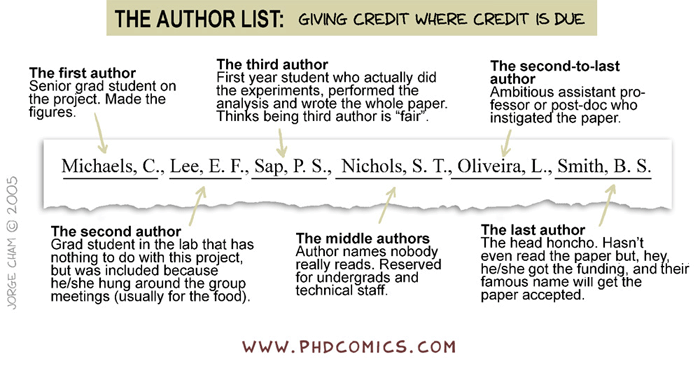There has always been a bit of good-natured humor when it comes to who gets credit for what in a long line of citations.
Occasionally, it can be strange, like when one person who contributed to the I.P.C.C. claims to be a Nobel laureate, but most often there is a pecking order to science papers.
This does not keep science humorosts like Jorge Cham at PhDComics.com from cutting to the heart of the matter, as they did on figuring out citations way back in 2005:
But a paper by Northeastern's Center for Complex Network Research takes a more serious approach to it and has created a new algorithm that sheds light on how to properly allocate credit.
Hua-Wei Shen, a visiting scholar at Northeastern and associate professor at the Institute of Computing Technology at the Chinese Academy of Sciences, developed the algoritm which led to the new credit allocation system based on how often the paper is co-cited with the other papers published by the paper's co-authors, capturing the authors' additional contributions to the field.
"The idea behind this is that based on an author's previous line of work, people have a perception of where the credit lies," explained Albert-László Barabási, Distinguished University Professor at Northeastern and director of the Center for Complex Network Research. "And the algorithm's goal is simply to extract that perception."
To test its hypothesis, the team looked at Nobel prize-winning papers in which the Nobel committee and the science community decided to whom the primary credit for a discovery should go. In 81 percent of the papers related to physics, chemistry, and medicine that they looked at, the credit allocation algorithm found that the authors deserving of the most credit corresponded to the Nobel laureate.
In all, the team looked at 63 prize-winning papers using the algorithm. In another finding, the algorithm showed physicist Tom Kibble, who in 1964 wrote a research paper on the Higgs boson theory, should receive the same amount of credit as Nobel prize winners Peter Higgs and François Englert. Barabási explained that the traditional system of credit allocation varies depending on the field of research, and being the first author listed on a paper does not mean that person would receive the most credit. In biology, for example, the authors listed first and last on a paper are generally the one's who receive credit while in physics the author list is often alphabetical.
"If you are not an insider in the field, you have absolutely no idea who should get the credit for the paper," Barabási said.
While the science community is usually correct when allocating credit to authors, sometimes credit can go to the wrong person. In their paper, the researchers wrote that "the ability to accurately measure the relative credit of researchers could potentially impact hiring, funding, and promotions."
Barabási also noted this new algorithm could help professors from different disciplines who collaborate on a research paper determine to whom the community would credit the paper.






Comments